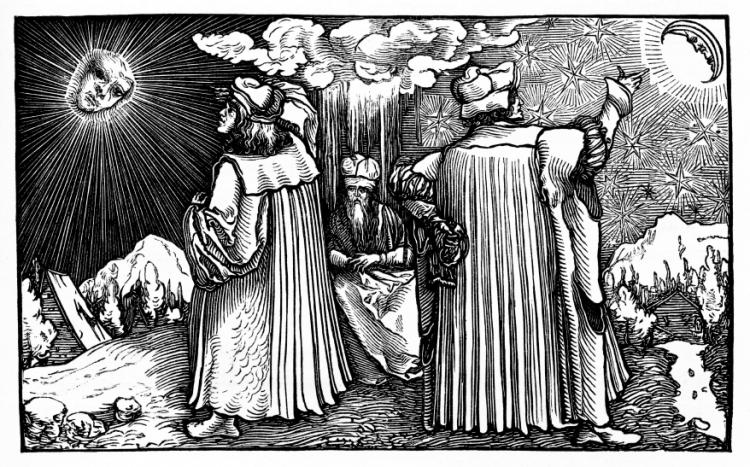

Hilton Head Island, Bluffton, & The Surrounding SC Lowcountry
Blog
Aug 18, 2017
Solar eclipses have historically been viewed as omens that bring about death and destruction. But in reality, they are harmless—and they even helped prove Einstein’s theory of relativity. The word eclipse comes from ekleipsis, the ancient Greek word for being abandoned.

Historically, many scholars have tried their best to understand and predict solar eclipses. ©iStockphoto.com/wynnter
The British Sir Arthur Eddington, used the total solar eclipse of May 29, 1919 to test Albert Einstein’s theory of general relativity.
By taking pictures of stars near the Sun during totality, Eddington was able to show that gravity can bend light. This phenomenon is called gravitational deflection.
A solar eclipse is also responsible for the discovery of helium. The first piece of evidence for the existence of the second lightest and the second most abundant element known to humans was discovered by the French astronomer Jules Janssen during a total solar eclipse on August 16, 1868. Because of this, it’s named after the Greek word for the Sun: Helios.
Surviving records have shown that the Babylonians and the ancient Chinese were able to predict solar eclipses as early as 2500 BCE.
In China, solar eclipses were thought to be associated with the health and success of the emperor, and failing to predict one meant putting him in danger. Legend has it that 2 astrologers, Hsi and Ho, were executed for failing to predict a solar eclipse. Historians and astronomers believe that the eclipse that they failed to forecast occurred on October 22, 2134 BCE, which would make it the oldest solar eclipse ever recorded in human history.
Clay tablets found at ancient archaeological sites show that the Babylonians not only recorded eclipses—the earliest known Babylonian record is of the eclipse that took place on May 3, 1375 BCE—but were also fairly accurate in predicting them. They were the first people to use the saros cycle to predict eclipses. The saros cycle relates to the lunar cycle and is about 6,585.3 days (18 years, 11 days, and 8 hours) long.
Like the ancient Chinese, the Babylonians believed that solar eclipses were bad omens for kings and rulers. Predicting solar eclipses enabled them to seat substitute kings during solar eclipses with the hope that these temporary kings would face the anger of the Gods, instead of the real king.
According to the Greek historian Herodotus, a solar eclipse in 585 BCE stopped the war between the Lydians and the Medes, who saw the dark skies as a sign to make peace with each other.
The Greek astronomer Hipparchus used a solar eclipse to determine that the Moon was about 429,000 km (268,000 mi) away from the Earth. This is only about 11% more than what today’s scientists accept as the average distance between the Moon and the Earth.
Although early eclipse pioneers, including Chinese astronomer Liu Hsiang, Greek philosopher Plutarch, and Byzantine historian Leo Diaconus tried to describe and explain solar eclipses and their features, it was not until 1605 that astronomer Johannes Kepler gave a scientific description of a total solar eclipse.
More than a century later, Edmund Halley, who the famous Halley’s comet is named after, predicted the timing and path of the total solar eclipse on May 3, 1715. His calculations were only 4 minutes and about 30 km (18 mi) off from the actual timing and path of the eclipse.
The scientific fascination with solar eclipses has led to some important scientific discoveries about the nature of the Sun, Moon, and our solar system.
| Year | Date | Type | Importance |
|---|---|---|---|
| 632 | January 27 | Annular | Visible in Medina, Saudi Arabia, the eclipse coincided with the death of Prophet Mohammad’s son Ibrahim. The Prophet reportedly dismissed rumors that this was a miracle, stating that the Sun and the Moon are signs of God and that they are not eclipsed for the birth or death of any man. |
| 1133 | August 2 | Total | King Henry’s Eclipse: King Henry I died shortly after the eclipse, prompting the spread of the superstition that eclipses are bad omens for rulers. |
| 1836 | May 15 | Annular | English astronomer Francis Baily first discovered and described Baily’s beads—a phenomenon that occurs in the seconds before and after totality in a total solar eclipse and annularity in an annular solar eclipse. |
| 1851 | July 28 | Total | The first photograph of the Sun’s corona was taken by a Prussian photographer called Berkowski. |
| 2009 | July 21/22 | Total | Longest total solar eclipse of the 21st century. Totality lasted for 6 mins and 39 secs. |
Information courtesy of Wikipedia


If you want to make a little piece of The Island your own, you need more than just a road map and a REALTOR. You need a partner who can make things happen.
Lifestyle
Communities
Activities
Home Sales Hit a Record-Setting Rebound
Jul 24, 2020